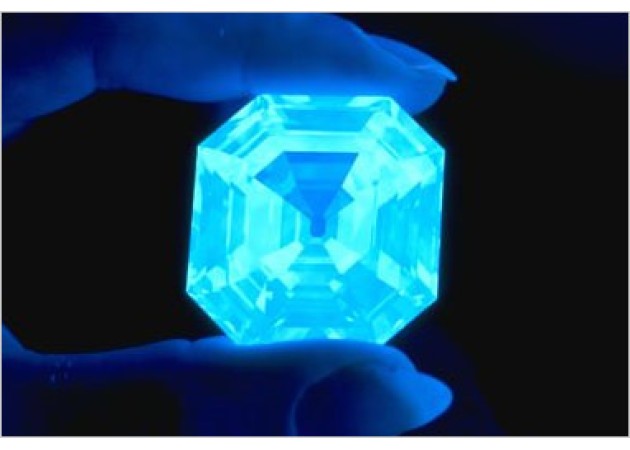Fluorescence In Diamonds

Diamond Fluorescence: A Closer Look
Diamond fluorescence is a phenomenon where diamonds emit a visible light when exposed to ultraviolet (UV) radiation. While often misunderstood, it can significantly impact a diamond's appearance and value.
Understanding Fluorescence
Fluorescence in diamonds is most commonly seen as a blue color, though a rare yellow fluorescence can occur. The intensity of fluorescence is graded on a scale ranging from 'None' to 'Extreme.' This information is typically included in a diamond's grading report from reputable laboratories like GIA, AGS, HRD, IGI, and EGL.
So is fluorescence in a diamond good or bad?
Evidence shows that because white diamonds progress in the colour charts to a yellow hue and fluorescence is primarily blue and a complimentary colour to yellow, this blue fluorescent colouring can actually improve the colour of a diamond by a grade or two. Having faint to medium fluorescence will not impact on the performance of a diamond and can make them appear whiter and closer to colourless. The market has discounted faint to medium fluorescence in diamonds by up to 20% regarding fluorescence as a type of inclusion although unnoticeable and non performance restricting. Fluorescence can not be seen under normal conditions and also give the diamond a unique finger print for security checks. In the southern hemisphere (Australia, South Africa/America and New Zealand) where there is more Ultra Violet light because of ozone depletion, slight to medium fluorescence does make diamonds appear whiter and this can only be a bonus!
When a diamond contains distinct, strong or extreme fluorescence it can make the stone appear oily, poorly polished and this can affect light performance. We would recommend clients to be careful with diamonds that have distinct, strong or extreme fluorescence. The negative attributes of having distinct and strong fluorescence are greater than the above mentioned positive. In saying that there is a substantial saving of up to 25% for these diamonds and they are only recommended after professional consultation which we are happy to provide. We would like to stress that we have seen and sold some spectacular diamonds with strong fluorescence and each individual stone must be judged on its own merits. Forty years ago, when we first joined the diamond industry the diamond to own was a ‘BLUE-WHITE’ diamond, i. e. a diamond with strong-blue fluorescence – it’s a fickle old world.
It is quite intriguing that diamonds that fluoresce are very rare and as we mentioned in earlier sections the scarcity of colour, cut, carat and clarity drive up the price of diamonds. It is interesting that having this natural and rare phenomenon actually decreases the price! Our expert opinion is that having faint to medium fluorescence is fine in diamonds from G to J as the colour could be improved at a reduction in price. Having strong, distinct and extreme fluorescence is not desired. For the purest looking for a D-IF that’s a D Flawless ‘the best a girl can get’ fluorescence will not improve your diamond so why bother? Well because any fluorescence in the stone will reduce the price of a diamond so be smart but avoid distinct, strong or extreme fluorescence unless we or our agents have approved it.
Frequently Asked Questions About Diamond Fluorescence
Q: What is diamond fluorescence?
A: Diamond fluorescence is a phenomenon where a diamond emits a visible light when exposed to ultraviolet (UV) radiation.
Q: How is fluorescence graded?
A: Fluorescence is typically graded on a scale from 'None' to 'Extreme', with blue being the most common color.
Q: Does fluorescence affect a diamond's appearance?
: Yes, it can. Faint to medium fluorescence can improve a diamond's appearance, while strong or extreme fluorescence can cause an oily or hazy look on extremely low clarity diamonds.
Q: Does fluorescence affect a diamond's price?
A: Generally, diamonds with faint to medium fluorescence are discounted, while those with strong or extreme fluorescence can be significantly cheaper.
Q: Can I see fluorescence in normal light?
A: No, fluorescence is only visible under strong UV light.
Q: Should I avoid diamonds with fluorescence?
A: Not necessarily. Faint to medium fluorescence can be beneficial, but it's essential to consider the overall appearance of the diamond.
Q: Can I see a diamond's fluorescence before buying?
A: Reputable jewelers can use UV lights to show you a diamond's fluorescence.
Q: Is fluorescence rare?
A: About 30% of diamonds exhibit some degree of fluorescence.
The Bottom Line
Diamond fluorescence is a fascinating aspect of these gemstones. While it can enhance the appearance of some diamonds, it's essential to weigh the pros and cons carefully. At CompareTheDiamond.com, we offer expert guidance and a wide selection of diamonds to help you find the perfect stone for your needs and preferences.
Remember, every diamond is unique, and fluorescence is just one factor to consider when making a purchase. By understanding this phenomenon, you can make an informed decision and select a diamond that truly shines.
Would you like to learn more about other diamond characteristics, such as the 4Cs or diamond cuts?

